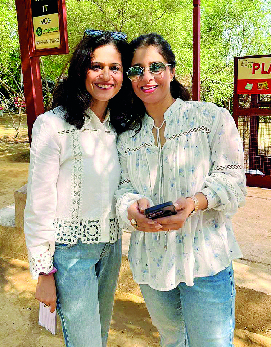
A waste recycling unit set up by I Am Gurgaon
Keeping waste out of landfills in Gurugram
Kavita Charanji, Gurugram
Competing with Gurugram’s glitzy skyline and its denuded Aravali range is another mountain rising to new heights every day. This is the infamous Bandhwari landfill which is fed 2,000 tonnes of garbage daily from Gurugram and Faridabad. The site, spread over 30 acres, is 40 metres tall, dwarfing the hills around it.
Toxins released by plastic, metals and biomedical waste indiscriminately dumped here have ruined air, water and soil — endangering not just the environment but the health of the residents of Bandhwari village.
But, let’s face it. Responsibility lies at the door of Gurugram’s residents. They can lend a hand by tackling their own household waste. Helping people do it is I Am Gurgaon, a reputed citizens’ initiative to green the concrete jungle of Gurugram. Its success in converting a large stretch of barren land into the lush Aravali Biodiversity Park is well known.
The group has set up three waste recycling units located at Samadhaan Hub, Badshahpur Forest Corridor and Creek 56. At the Prachin Hanuman Aur Shani Dev Mandir only flowers and festive waste are collected. On any given day, residents can bring their dry waste to any of these centres.
A visit to the Samadhaan Hub sustainable solutions centre in Block D, Sector 26A near Khushboo Chowk reveals how I Am Gurgaon's units work. Set up in partnership with the Municipal Corporation of Gurgaon (MCG), the Hub is where corporates, RWAs, citizens, schools can drop off segregated, clean and dry wastepaper, plastic, e-waste, metal, glass, clothes, expired and unexpired medicines, and medical equipment.
Through informative exhibits, visitors learn about little-known facets of waste and its management. Interactive workshops on dry waste segregation are held with schools, RWAs and corporates. They can also participate in events like community clean-up drives and engage in interesting workshop sessions.
 |
| Namrita Chaudhri and Anjali Khatri |
“The main idea behind our recycling units is that nothing should go to the landfill. Wet waste can easily be composted at home. However, dry waste is n on-biodegradable and this was a challenge for people,” says Anjali Khatri, founder-member, I Am Gurgaon.
To solve this problem, the group partners with NGOs and organizations that recycle waste. Soft and multi-layered plastics and religious waste go to an organization called Avacayam. Here people with special needs turn the waste into beautiful gift items like planters, bags and mats. They also make incense sticks and Holi colours, among other items.
Hard plastics are sent to local recyclers in Delhi, Noida and Gurugram. They are then reused for making roads.
NAMO, India’s largest e-waste recycler, picks up e-waste while clothes are donated to Goonj. The proceeds from paper waste are donated to Freepathshala and fund the education of underprivileged children and children of construction workers.
Under a tie-up with Inchpaper for its Har Haath Kitaab (A Book in Every Child’s Hand) project, textbooks are donated as learning material to NGOs for teachers and students, while storybooks go to community libraries and reading clubs. Workbooks, unused notebooks and practice worksheets turn into valuable resources for underprivileged children.
Metal is picked up by the e-waste vendor and local recycler. Like glass, it is repurposed. Medicines and medical equipment are collected at the units. The expired medicines are incinerated by a hospital while unexpired medicines are donated to charitable dispensaries and hospitals.
“We offer solutions for most kinds of dry waste. We are very particular about who we give the waste to. Our recyclers are verified and we ensure that they are recycling them the correct way,” says Namrita Chaudhri, core team member of I Am Gurgaon.
Between 2022 and June 2024, I Am Gurgaon collected 174,831 kg of dry waste. If the units hadn’t been around, the waste would have probably ended up in landfills like Bandhwari. As it is, the city sends an estimated 1,200 tonnes of waste every day to landfills.
This scenario is avoidable with greater public awareness and stricter implementation of solid waste management laws by the government. From time to time plastic bans have been enforced but they are sporadic and half-hearted. Products like bio waste, cosmetics, disposable single-use plastic plates and cups go to landfills but waste can be minimized.
Over the years, I Am Gurgaon has run a series of awareness campaigns to motivate citizens to take responsibility for their waste. “Our mantra is Refuse, Reduce, Reuse, Recycle, Repurpose,” says Chaudhri.
They have carried out Bring Your Own Bag (BYOB) campaigns at markets, initiated the setting up of art installations made of waste and, says Khatri, helped transform Shri Ram School into a “No Plastic Bag Zone”.
At Shri Ram School they ran a campaign to reduce the use of plastic and polypropylene bags during their Open Days, distributed free canvas bags through waste interactive games, and initiated pledges by parents, students and faculty to forgo the use of plastic bags and encourage others to do the same. “Today the school proudly displays a sign outside saying that it is a ‘No Plastic Zone’. We hope more schools are inspired to do the same,” says Khatri.
Comments
Currently there are no Comments. Be first to write a comment!



